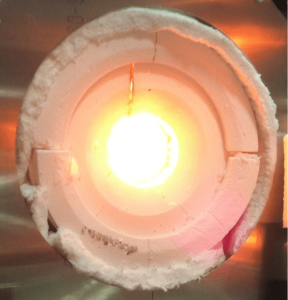 Krishnan Rajeshwar, past ECS president, editor-in-chief of the ECS Journal of Solid State Science and Technology, and a leading researcher in solar fuels, was recently featured on the podcast Conceptual Science where he discusses solar fuels, their chemistry, challenges, and prospects. Co-hosts John and Tracy Suchocki describe the interview as one of their more technical episodes—what better audience to tune in that ours! So if you’re into chemical reactions, particularly oxidations and reductions, this may be of interest. (more…)
Krishnan Rajeshwar, past ECS president, editor-in-chief of the ECS Journal of Solid State Science and Technology, and a leading researcher in solar fuels, was recently featured on the podcast Conceptual Science where he discusses solar fuels, their chemistry, challenges, and prospects. Co-hosts John and Tracy Suchocki describe the interview as one of their more technical episodes—what better audience to tune in that ours! So if you’re into chemical reactions, particularly oxidations and reductions, this may be of interest. (more…)
Renewable Liquid Fuels: Energy Storage & Transportation
Posted on December 29, 2016 by Amanda Staller Renewable energy is on the rise, but how we store that energy is still up for debate.
Renewable energy is on the rise, but how we store that energy is still up for debate.
“Renewable energy is growing, but it’s intermittent,” says Grigorii Soloveichik, program director at the United States Department of Energy’s Advanced Research Projects Agency. “That means we need to store that energy and we have two ways to do that: electricity or liquid fuels.”
According to Soloveichik, electricity and batteries are sufficient for short term energy storage, but new technologies such as liquid fuels derived from renewable energy must be considered for long term storage.
During the PRiME 2016 meeting in October, Soloveichik presented a talk titled, “Development of Transformational Technologies,” where he described the advantages that carbon neutral liquid fuels have over other convention means – such as batteries – for efficient, affordable, long term storage for renewable energy sources.
Rise of renewables
In the United States, 16.9 percent of electricity generation comes from renewables – a 9.3 percent increase since 2015. Globally, climate talks such as the Paris Agreement help bolster the rise of renewable energy around the world. Soloveichik expects that growth to continue in light of the affordability of clean energy technologies and government mandates that aim at environmental protection and a reduction of the carbon footprint. However, the continued rise in renewable dependence will impact the current grid infrastructure.
“More renewables will result in more stress on the grid,” Soloveichik says. “All of these new sources are intermittent, so we need to be able to store huge amounts of energy.”
More Efficient Materials for Solar Fuel Cells Developed
Posted on February 18, 2016 by Amanda Staller
Krishnan Rajeshwar, ECS senior vice president and co-founder of UTA’s Center for Renewable Energy, Science and Technology
New research headed by ECS senior vice president Krishnan Rajeshwar has developed “green fuels” to power cars, home appliances, and even impact critical energy storage devices.
Solar fuels addressing global issues
Rajeshwar’s research works to address critical global and environmental issue by creating an inexpensive way to generate fuel from harmful emissions such as carbon dioxide.
(MORE: Read additional publications by Rajeshwar.)
The University of Texas at Arlington professor and 35 year ECS member has developed a novel high-performing material for cells that harness sunlight to split carbon dioxide and water into usable fuels like methanol and hydrogen gas.
From harmful to helpful
“Technologies that simultaneously permit us to remove greenhouse gases like carbon dioxide while harnessing and storing the energy of sunlight as fuel are at the forefront of current research,” Rajeshwar said. “Our new material could improve the safety, efficiency and cost-effectiveness of solar fuel generation, which is not yet economically viable.”
(MORE: Read the full study as published in ChemElectroChem Europe.)
This from University of Texas at Arlington:
The new hybrid platform uses ultra-long carbon nanotube networks with a homogeneous coating of copper oxide nanocrystals. It demonstrates both the high electrical conductivity of carbon nanotubes and the photocathode qualities of copper oxide, efficiently converting light into the photocurrents needed for the photoelectrochemical reduction process.
Bill Gates—tech mogul, business magnate, and philanthropist for all things good—recently spoke to CNN about the newest technology he believes could transform the world’s energy infrastructure: solar fuels.
Solar fuels have the ability to address energy storage intermittency issues, which is currently one of the biggest challenges in sustainable energy technology according to Gates.
Nate Lewis, ECS member since 1982, is one of the leading scientists at the forefront of solar fuel research. Taking inspiration from nature, Lewis and his team aspire to mimic the naturally occurring process of photosynthesis but with higher efficiency levels. Through taking the energy of the sun and storing it in chemical fuels, Lewis and other researchers in the field are propelling the vision of a clean, efficient, and affordable future of energy.

By concentrating sunlight into reactors, H2O and CO2 can be split to form liquid fuels.
Image: The Conversation/David Hahn
The sun produces an astronomical amount of energy each day, but scientists and engineers are still trying to better understand how to convert that energy into an efficient, usable form. Recently, work in photovoltaics deals with utilizing different materials, new arrangements of cell components, and interdisciplinary work to improve efficiently levels. However, a new and exciting area of photovoltaics is now rising in the ranks: turning sunlight into liquid fuels.
With this new development on the rise, the possibility of one day filling our cars with solar-generated fuel is on the horizon.
Researchers are giving more attention to the production of solar fuels because energy conversion and storage and simultaneously covered under one technique. It will give solar energy a wider scope due to more utilization opportunities, whereas conventional photovoltaic energy is only being used for one-third of the day when sunlight is at its peak.
Currently, the greatest roadblock lies in commercialization of the man-made solar fuels due to the substantial amount of energy it takes to break down stable CO2 and H2O molecules.
However, researchers are also exploring aspects of artificial photosynthesis through electrochemistry to help produce efficient, affordable man-made solar fuels.
Further material from the ECS Digital Library:
Read more about processes and current projects on The Conversation.
PS: Watch Ralph Brodd, a pillar of electrochemical science and technology with over 40 years in the electrochemical energy conversion business, talk about the future of the energy infrastructure and how it has transformed over the years.


